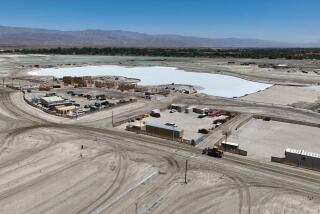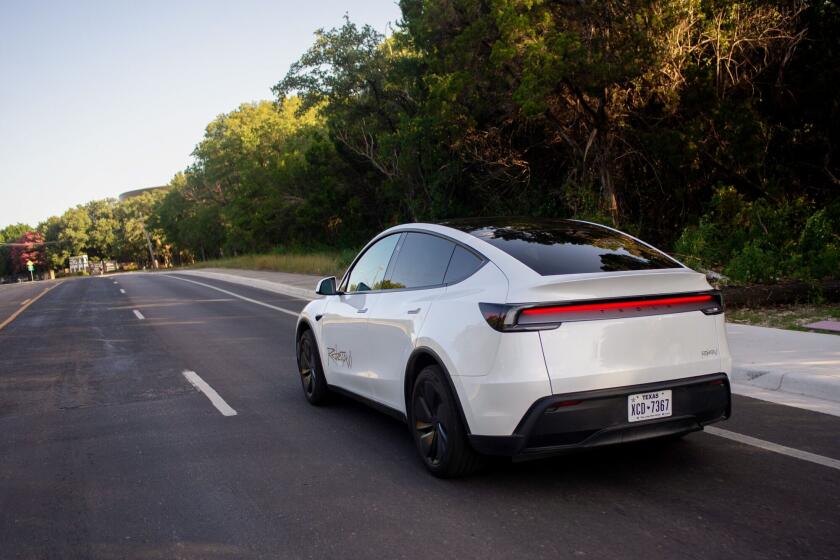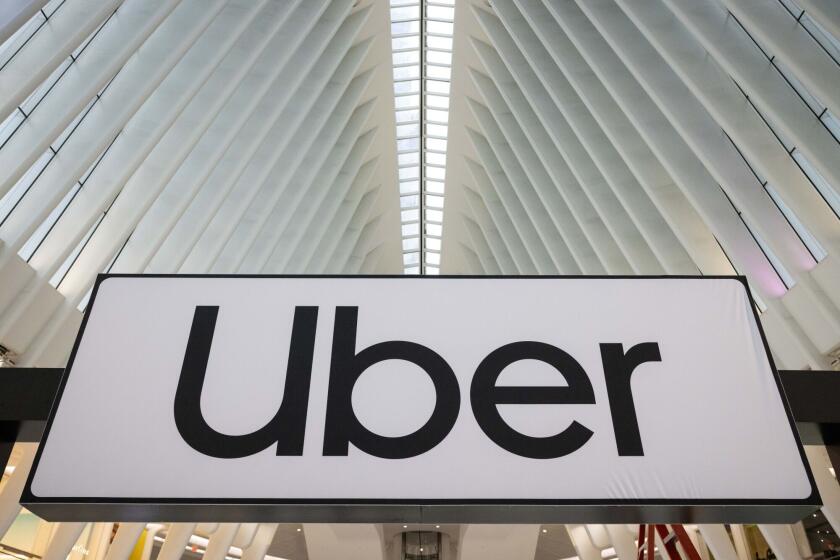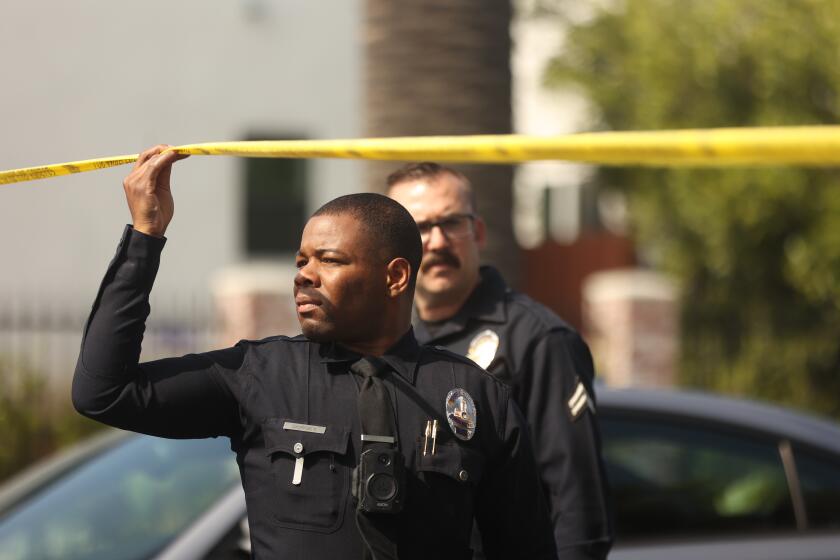Taking the Sting Out of the Road : Highway: A community-backed plan calls for covering part of the Interstate 15 corridor down 40th Street, utilizing the decks for parks and other facilities.
- Share via
Culminating decades of controversy and debate, planners Tuesday will unveil an almost $300-million redevelopment effort to complete the Interstate 15 corridor through San Diego’s Mid-City area, a working-class, racially mixed community northeast of downtown.
The proposal seeks to transform a nine-block-long swath of 40th Street--now a traffic-laden, debris-strewn eyesore of vacant lots and crime--into an opportunity to revitalize and unify the neighborhood.
A consultant team headed by a Boston architectural firm is behind the plan.
Two major commercial arteries--University Avenue and El Cajon Boulevard--intersect the planned north-south freeway, which would run below what is now 40th Street, through the center of the City Heights neighborhood and along the flanks of the Kensington and Normal Heights communities.
The plan calls for covering much of the roadway, which would be recessed 25 feet, with a novel series of bridges and decks, on which new parks, village squares, bicycle and pedestrian paths, mass-transit centers and other amenities would be built.
Facilities might include a post office, police substation, parking spaces and stores. Ventilation shafts would be installed to disperse hazardous vehicle emissions from below.
Similar freeway covers or decks have been completed or are under construction in Phoenix, Seattle and Boston, a nationwide trend that planners say recognizes the ruinous effects of highways through inner-city communities.
The Interstate 15 corridor in San Diego would be the first such cover project in California, planners said, despite the state’s identification with freeways and cars.
“The freeway was thrust upon the community; we didn’t ask for it,” said John William Stump III, an attorney and neighborhood resident who serves with the City Heights Community Development Corp., the nonprofit group that hired the freeway-consultant team.
“Basically, we were presented with a lemon of a freeway, and we’re trying to make lemonade out of it,” Stump said.
The plan is to be unveiled today at a 6 p.m. meeting at the City Heights Recreation Center, 3777 44th St. The consultants held several local forums, generating community suggestions and concerns that have been reflected in the plan.
“There has been extraordinary interest within the community,” said Steven Cecil, director of urban design for CBT Architects, the Boston firm that headed the consultant team.
“This is revolutionary in the sense that you’re looking at a major freeway project as a revitalizing opportunity,” he said. “We normally think of freeways as something that we have to tolerate.”
The highway will connect Interstate 8 and Mission Valley in the north to Interstate 805 and Southeast San Diego in the south.
Plans for the highway’s final 2.2-mile link have been under study for three decades; it is the only remaining unfinished portion of the Mexico-to-Canada highway, planners said. The stretch, from Landis Street north to Adams Avenue, has proved the most problematic.
Planners envision “town centers” above the freeway as possible sites for artistic and ethnic festivities, marking the neighborhood’s cultural and sociological mixture: the surrounding area, with a population of about 50,000, is about 50% white, 22% Latino, 15.5% black, and 12.5% Asian-American, including a large number of recent immigrants from Southeast Asia, whose presence is reflected in the many Vietnamese-language shop signs.
Funding remains in question. About $149 million in state and federal money is committed, officials said, but the plan to be outlined today would require substantial revisions to the preliminary California Department of Transportation blueprint.
Total costs of the new plan are estimated at $281 million; advocates want to fill the shortfall with a mixture of federal, city and private funds.
San Diego-area congressional representatives have vowed to work to achieve U.S. Interstate designation for the portion that remains California 15, thus freeing more federal funds for the project.
Backers hope the City Council will adopt the proposal and work out procedural and funding changes with Caltrans and other agencies involved.
Construction is expected to begin late this year or in early 1992; completion is not expected for five years.
State officials said they are receptive to the projected revisions, but are cautious about funding.
“From Day One, Caltrans has been working with all the community groups,” said Kyle Nelson, a Caltrans spokesman in San Diego. “We would really like to see this completed, not only for the motorists, but for the community as a whole.”
The consultant’s plan calls for three blocks of covered freeway, or about 15 acres. The Caltrans plan calls for two blocks of cover (about 10 acres), one block to be funded by the state and the other by the city. Many residents want the entire stretch covered, but funding for such an effort seems unlikely.
The consultants’ plan--financed with $145,000 in Community Block Grant money--also calls for:
* Modified interchanges and freeway ramps to allow for greater roadway cover, safer traffic circulation, reduced community disruption and improved access for pedestrians and bicycle riders.
* Improved mass-transit centers and connections, including space for a potential trolley line in the median of the future highway.
* Major community centers at University Avenue and El Cajon Boulevard, where the two roadways would pass above the freeway, hopefully attracting retail centers, restaurants, markets and public-use facilities.
Much of the area is now desolate; dozens of homes and apartment buildings have been demolished after right-of-way acquisition. (Caltrans has purchased 223 of 303 needed parcels.) Palm trees and power lines stand in stark relief in an otherwise bare cityscape; foundations and stairs are all that remain of many homes in what was once a thriving neighborhood.
Residents say abandoned buildings served as drug houses and transient centers until they were belatedly demolished, leaving the area with its current withered look. Two schools face 40th Street.
“It’s like a ghost town around here,” said Federico Lopez, 30, who has lived along Polk Avenue near 40th for two decades and has watched the neighborhood disintegrate from a stable community.
Lopez has placed bars on the windows of his one-story stucco home. Burglars have broken in three times, he says.
“It’s really dangerous around here now,” concurred his neighbor, Rosie Ramos, who says she’s terrified of thieves who prowl the area.
Both homes are destined to be demolished for the freeway.
“I can’t wait to get out,” said Lopez, a delivery driver and father of two, who was surprised to learn that his home is the projected site of a park on a freeway cover area.
“They need to do something around here,” Lopez said. “I hope it gets better.”
More to Read
Sign up for Essential California
The most important California stories and recommendations in your inbox every morning.
You may occasionally receive promotional content from the Los Angeles Times.













